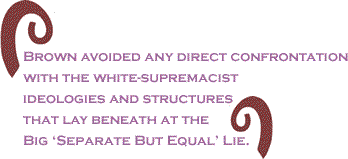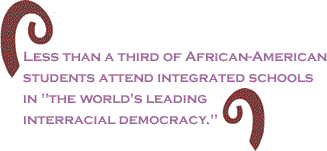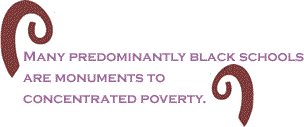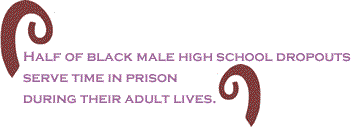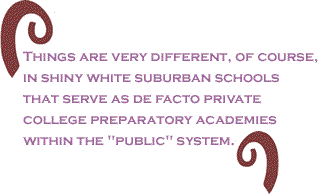
|
|||||||||||||||||||||
|
Can it really be 50 years since the United States Supreme Court ruled in Brown v.The Board of Education that legal race separation was inherently unequal and therefore unconstitutional in public education? The story and meaning of Brown v. Board is being told, re-told, analyzed, and in some cases even re-enacted in numerous anniversary events across the country this spring. Many of the participants in these events are in "no mood to throw a birthday bash for Brown," as University of California (San Diego) law professor Roy L. Brooks recently noted at a May 10th conference held by The Chicago Urban League. There are good reasons for the qualified nature of Brown's celebration. Any honest and accurate assessment shows that the lessons and legacy of Brown provide little basis for American self-congratulation. "With All Deliberate Speed”
The Brown decision was anything but a forthright assault on racial segregation and inequality. Crafted to achieve buy-in from moderates and racists within and beyond the bench, it avoided any direct confrontation with the white-supremacist ideologies and structures that lay beneath the Big "Separate But Equal" Lie. Consistent with its tepid language, Brown failed to mandate a reasonably rapid remedy for the crime of educational apartheid. Its timid requirement that school desegregation proceed "with all deliberate speed" bore predictably limited short-term fruit. Just one percent of southern black children attended even partly desegregated schools 10 years later.
There were real integrationist and related egalitarian victories, especially in the South and during the second decade out. By Brown's 20-year anniversary, nearly half (46 percent) of black students attended integrated, majority-white schools. Since this meant greater access for black children to better-funded, better-equipped, and more "middle-class" schools, African-American kids' achievement levels and high-school graduation rates rose considerably. The currently much bemoaned racial "achievement gap" fell by half between 1954 and 1974. Still Separate
During the last nearly two and a half
decades, however, the flesh of desegregation has been largely
stripped from Brown's A big part of this has to do with "white-flight" out of predominantly black and Hispanic cities. Another has to do with policy. Particularly relevant here is the Supreme Court's decision during the mid-1970s that Brown could not be interpreted to require integration across city and suburban lines. That decision ensured that the racial composition of local school districts would mirror America's starkly segregated residential landscape, reflecting and furthering the division of our great metropolitan areas between predominantly black, brown and poor cities and more affluent, predominantly white suburbs. Let me present a few notes from my home base. The current black-white school "segregation index" for the Chicago metropolitan area is 84, which means that 84 percent of black kids in the 6-county region would have to switch school districts in order for African-American children to be evenly distributed throughout the area's schools. The black school "isolation index" is 78, meaning that the average black kid in the area attends a school that is 78 percent black. Within Chicago itself, the black-white segregation index is higher (88 percent) than in the metropolitan area and 54 percent of black students attend schools that do not have a single white student. With at least some justice, the city's public school officials note that they don't have enough white students left to justify the judicial desegregation order they have been (supposedly) operating under since the early 1980s. In the Midwest, the HCRP reports, 46 percent of black kids attend schools that are 90 to 100 percent black. In Illinois and Michigan, 61 and 63 percent of black kids, respectively, go to such schools. In California and New York, less than 14 percent of black students attend majority white schools. Still Unequal: Preserving Privilege
American schools are still separate. What about the promise of equality? Many activists and intellectuals argue – with no small justice – that separate is not in fact inherently unequal and that black kids don't necessarily have to sit next to white kids in racially balanced schools to learn. Fair enough, but separation still translates into inequality under current really existing conditions of American spatial, racial and socioeconomic stratification. Let's start with money, understood at two levels. The first level is the money possessed by the students' families. Many predominantly black schools are monuments to concentrated poverty. According to the HCRP, 61 percent of children are poor in schools that are 50 to 60 percent black and Latino. In schools that are 90 to 100 percent black and/or Latino, 88 percent of the kids are poor.
This reflects a privilege-preserving school-funding system that bases per-student expenditures largely on the local property tax base – a wonderful U.S. formula that is technically "color-blind" but in fact heavily racialized, thanks to persistent black residential segregation (and discrimination) and persistent huge racial wealth disparities that have deepened considerably since 2001. As one black elementary school student asked the prolific author and educational justice witness and spokesman Jonathan Kozol, "why do those who need the most get the least and those who need the least get the most?" Indeed. There are rich white districts in the Chicago suburbs that spend as much as $15 to $18,000 per year per student. Median household income for families with children under 18 in such communities is well into the six figures. There are poor black Chicago suburban districts than spend less than $7,000 per year and yet where median household income is less than $31,000. Educational Apartheid: Beyond the Funding Gap
As Kozol recently pointed out in an eloquent keynote speech at a conference I helped organize in Chicago, per-student spending disparities tell only one part of the story of the "savage [school] inequalities" that persist under the post-Brown system of "educational apartheid." Inner-city black and Latino students' senses of beauty and dignity are still assaulted by rotting school structures, archaic bathrooms, stinking corridors, and decrepit school materials. They still suffer from chronic instability and under-qualification on the part of their teachers. Their chances for learning are still challenged by overcrowded classrooms with inordinately high student-teacher ratios. Their aspirations to create successful and democratic lives are "amputated" by teachers and school officials who see them as incapable of grasping higher thoughts, attending college, finding useful work, and participating as full citizens. Their natural love for learning is crushed on the wheels of a neo-Dickensian, proto-militarized, and standardized-test-based "skill and drill" curriculum that values rote memorization over critical and creative thinking. They have far less access to advanced college-preparatory high school courses than do students in more affluent and whiter school districts. They know more about the names of their state's prisons than they do about those of their state's universities, and for good reason. In the spring of 2001, there were 20,000 more black males in Illinois state prisons than in the bachelors' programs of the state's public universities. In Chicago, the city schools chief continually reports a high-school drop rate of 13 percent in spite of abundant, readily available research showing that the rate is much higher and that less than half of the city's black 9th graders make it to graduation. It seems worth noting that half of black male high school dropouts serve time in prison during their adult lives. Even some of the most dedicated and heroic public school teachers are driven out of urban schools by the soulless, mind-numbing, test-targeted anti-pedagogy that school systems and public authorities impose with special vengeance on the urban poor. The centrally scripted lesson plans that urban school directorates inflict on "neighborhood" schools are derided by the actual classroom practitioners as "teacher-proof materials." They are designed to inoculate young minds against democratic imagination and to encourage a dangerously bored and authoritarian mindset.
The corporate-Stalinist curriculum is accompanied by stern lectures on "accountability" from officials who typically know and care little about the art of teaching and the challenges faced by staff and pupils in inner city schools. These lectures are unaccompanied by the resources required to meet the un-funded mandates set by such legislative atrocities as the perversely plagiarist "No Child Left Behind Act." Things are very different, of course, in shiny white suburban schools that serve as de facto private college preparatory academies within the "public" system. These latter schools attract many of the best, most energized teachers who flock to the opportunity to practice their craft in safe and pleasing structures with low student-teacher ratios. They enjoy the best and latest materials and the freedom to challenge students who expect to spend their late teens and early 20s in higher education, not ghettoized prisons and prison-like ghettoes. Sadly, large numbers of black, Latino, and liberal-white urban education officials, policymakers and civil rights leaders are all-too-willing to "play ball" with this savagely unequal and authoritarian system. Having given up on the struggle for meaningful integration and equality, they sign on with the latest recommended seven steps to turn inner city and black suburban ring schools into successful apartheid institutions. “A Country Which Daydreams About Exporting Its Democracy" I recently read (for the first time
I am embarrassed to say) Kozol's first classic book, Death
at An Early Age: the Destruction of the Hearts and Minds of Negro
Children in the "These seem amazing facts," Kozol writes, "in a country which daydreams about exporting its democracy. Looking at these figures openly," he concludes, "it is hard not to wonder whether we did not export our democracy a long time ago and now don't have very much left for our own people." That simple and elegant formulation on the intimate relationship between empire and inequality was written in 1966. It applies to 2004. Curious Public Priorities and the “Calendar of Improvements”
Later in Death At An Early Age (one of the great documents of moral witness in modern literature), Kozol addressed the insipid faith of liberals that "things are changing" in the right direction for black children. The liberals' "schedule for correction of grievances," he noted, "was plotted so slowly. Is there any reason to think it will be different in the future? Next year some integrated readers in a few schools, maybe. And then, with luck, some day later on, they may even use ... racially honest readers in public schools all over town... And then one day possibly not merely the texts but real children in the real schools also will be integrated and will no longer go to school separately but will be sitting in the same classrooms side by side. In that day, five, twenty years hence, possibly the teachers as well will begin to think of things differently and will no longer assume that Negro children are poor material because they will not read books that deny them and because they will not work out their hearts for white teachers who despise them. Perhaps, by the time another generation comes around, the great majority of these things will be corrected. But if I were the parent of a Negro child in school today I know that I would not be able to accept a calendar of improvements that was scaled so slow" (pp. 83-84). It's a generation later and the masters' "calendar of improvements" has turned out to be slower than anyone might have imagined. As Kozol said last Monday in Chicago, there's no reparation for the betrayal and poisoning of a childhood. Neither the liberals nor the "conservatives" – better now perhaps to say "the conservatives and the Radically Regressive Republicans" – have much to offer the forgotten children of color, contemptuously abandoned to their own devices in the de-industrialized, hyper-segregated slums of the inner city and the growing poor black suburban ring that absorbs a rising share of gentrification's outcasts. For many of those children, boys especially (but not at all exclusively), school is just a first step on the path to incarceration and lifelong felony marking. The average annual cost of incarceration, it seems worth noting, is $30,000 – an interesting statement of public priorities when compared with the cost of educating a child. Fifty years is a fair passage of time even by the gradualist measure that framed the Brown decision. In the period when the most progress was attained under Brown, it's also worth noting, many activists spoke the by-now forgotten language of revolution as well as reform. Maybe it's time to think more along the lines of the former term. We've seen where timid faith in liberal progress and appeasement has brought us. "The schedule for the correction of grievances" is in need of sharp acceleration. Paul Street ([email protected]) is an urban social policy researcher in Chicago, Illinois. He is the author of more than one hundred articles, including "Too Many Children Left Behind: The Case Against School Vouchers," Z Magazine (September 2002): 46-50. |
May
27 2004 |
|||||||||
|
|||||||||
|
|
|||||||||
| Printer Friendly Version | |||||||||
 |
|||||||||
| |
|||||||||
| |
|||||||||























